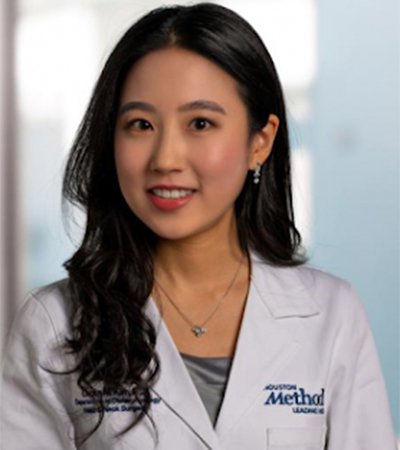


restorative medicine
When Art and Science Meet: Microvascular Reconstruction

Laura Minhui Kim, MD, MSc
Laura Minhui Kim, MD, MSc securely gripped the suture needle with her gloved fingertips. Working under a high-power microscope, she gingerly threaded through blood vessel tissue, re-establishing “plumbing”–or blood flow–to the patient’s skin graft. Keeping her hands steady, she worked for an additional two hours sculpting the skin graft to sit naturally on the patient’s scalp.
In microvascular reconstructive surgeries like this, Kim’s creative eye is essential. Her techniques help fuse donor tissue to the skin around it as it heals, with the goal of appearing as if nothing ever happened. That was of particular importance to Anthony Hood, a 63-year-old healthy male presenting with asymptomatic angiosarcoma, a rare but severe skin cancer.
“For this type of cancer, it needed to be removed with a wider margin of healthy tissue to ensure that it didn't come back locally or regionally,” explained Kim, a Head and Neck Oncology and Reconstructive Surgeon. “However, removing the tumor would leave Anthony with a large defect on his scalp.”
To address this defect, Kim harvested donor tissue from the latissimus dorsi muscle, carefully ensuring blood vessels within the donor tissue remained intact. The tissue was then placed on the scalp, where Kim performed microvascular reconstruction to re-establish blood flow. Then she expressed her artistic side.
“Without additional shaping, the donor tissue can almost look like a meat helmet or appear lopsided,” the Associate Professor of Otolaryngology said. “In Anthony’s situation, being otherwise healthy and concerned about cosmesis, I spent extra time contouring the donor tissue. In other cases, however, cosmesis is a second objective.”
Like all surgeries, there are risks. Adverse outcomes of microvascular reconstruction include kinks or twists in the blood vessels which can cause clotting and poor blood supply to the donor tissue site. Chances of these events occurring during the five-day post-op hospital stay are minimal, but if they do occur, they are often fixed via another trip to the operating room.
1
Asymptomatic angiosarcoma is removed with a wide margin to ensure the cancer doesn’t come back locally or regionally.
2
Blood flow is re-established with the patient’s skin graft.
3
The final result restores the patient to their previous state as close as possible.
As for Hood, who embraced one of the scariest times of his life with positivity, he was able to undergo radiation and is now under cancer surveillance.
“I joked with the oncologist: the two scariest words in the English language are ‘cancer’ and the ‘IRS,’” Hood said with a laugh. But in all seriousness, “surgery is never a pleasant experience for anybody, but the team at Houston Methodist was exceptional. They were really looking out for me.”
Happy with his appearance post-op, Hood emphasized that regular exercise and a healthy diet played a big role in his recovery and health outcomes. This experience was also a reminder of what really matters in life.
“I have so many things to live for,” he said. “Dr. Kim was a blessing. she really has a heart for this kind of work.”
Kim looks forward to helping more cancer patients concerned with cosmesis.
“This case highlighted my passion to make patients look as close to their previous state as possible, because I know it affects their social life, psyche, and mood, which in turn affects their recovery,” she said. “As cancer surgeons, we should try to optimize aesthetics where possible.”
Beyond clinical care, Kim contributes to research and helps train the next generation of head and neck surgeons.
Callie Rainosek Wren, MS
May 2025
Share this story
Related Articles




